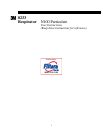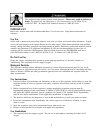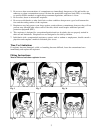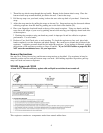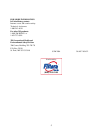
2
This respirator helps protect against certain particles. Misuse may result in sickness or
death. For proper use, see supervisor, or User Instructions, or call 3M in U.S.A.,
1-800-247-3941. In Canada, call Technical Service at 1-800-267-4414.
IMPORTANT
Before use, wearer must read and understand these User Instructions. Keep these instructions for
reference.
Use For
Solids such as those from processing minerals, coal, iron ore, flour, and certain other substances. Liquid
or non-oil based particles from sprays that do not also emit vapors. Metal fumes produced from welding,
brazing, cutting and other operations involving heating of metals. Radioactive particulate materials such as
uranium and plutonium. For additional information on 3M use recommendations for this class of
respirator please consult the 3M Respirator Selection Guide found on the 3M OH&ESD web site at
www.3M.com/occsafety or call 1-800-243-4630 in U.S.A. In Canada call 1 800 267-4414.
Do Not Use For
Gases and vapors, including those present in paint spraying operations, oil aerosols, asbestos or
sandblasting. This respirator does not supply oxygen.
Biological Particles
This respirator can help reduce inhalation exposures to certain airborne biological particles (e.g. mold,
Bacillus anthracis, Mycobacterium tuberculosis, etc.) but cannot eliminate the risk of contracting infection,
illness or disease. OSHA and other government agencies have not established safe exposure limits for
these contaminants.
Use Instructions
1. Failure to follow all instructions and limitations on the use of this respirator and/or failure to wear this
respirator during all times of exposure can reduce respirator effectiveness and may result in sickness
or death.
2. Before occupational use of this respirator a written respiratory protection program must be
implemented meeting all the requirements of OSHA 29 CFR 1910.134 such as training and fit testing
and applicable OSHA substance specific standards. In Canada, CSA standard Z94.4 requirements
must be met and/or requirements of the applicable jurisdiction, as appropriate.
3. The particles which can be dangerous to your health include those so small you cannot see them.
4. Leave the contaminated area immediately and contact supervisor if dizziness, irritation, or other
distress occurs.
5. Store the respirator away from contaminated areas when not in use.
6. Dispose of used product in accordance with applicable regulations.
Use Limitations
1. This respirator does not supply oxygen. Do not use in atmospheres containing less than 19.5%
oxygen.



